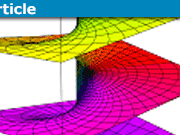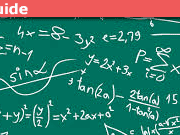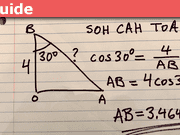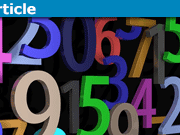Is There a Rigorous Proof Of 1 = 0.999…?
Yes.
First, we have not addressed what 0.999… means. So it’s best first to describe what on earth the notation [tex]b_0.b_1b_2b_3…[/tex] means. The way mathematicians define this thing is
[tex]b_0.b_1b_2b_3…=\sum_{n=0}^{+\infty}{\frac{b_n}{10^n}}[/tex]
So, in particular, we have that
[tex]0.999…=\sum_{n=1}^{+\infty}{\frac{9}{10^n}}[/tex]
But all of this doesn’t make any sense until we define what the right-hand side means. There is an infinite sum there, but what does that mean? Well, we put
[tex]S_k=\sum_{n=1}^{k}{\frac{9}{10^n}} \ ,[/tex]
then we have a finite sum. So, for example
[tex]S_1=0.9, \ ~S_2=0.99, \ ~S_3=0.999, \ etc.[/tex]
So, in some way, we want to take the limit of this sequence.
Let’s consider a particularly simple sequence to illustrate the idea behind the definition of a limit of a sequence: 1/2, 1/3, 1/4,… The terms in this sequence get smaller and smaller. You might think that it’s obvious that it goes to 0, or that it’s obvious that a smart mathematician can prove that it goes to 0, but it’s not. It’s impossible to even attempt a proof until we have defined what it means for something to go to 0. So we have to define what the statement “1/2, 1/3, 1/4,… goes to 0” means before we can attempt to prove that it’s true.
This is the standard definition: “1/n goes to 0” means that “for every positive real number [itex]\epsilon[/itex], there’s a positive integer N, such that for all integers n such that [itex]n\geq N[/itex], we have [itex]|1/n| < \epsilon[/itex]”. With this definition in place, it’s quite easy to prove that “1/n goes to 0” is a true statement. I want you to see here that we chose this definition to make sure that this statement would be true. The first mathematicians who thought about how to define the limit of a sequence might have briefly considered definitions that make the statement “1/n goes to 0” false, but they would have dismissed those definitions as irrelevant because they fail to capture the idea of a limit that they already understood on an intuitive level.
So the real reason why 1/n goes to 0 is that we wanted it to! Similar comments hold for the sequence of partial sums that define 0.999… It goes to 1 because we have defined the concepts “0.999….”, “sum of infinitely many terms”, and “limit of a sequence” in ways that make 0.999…=1. Can we define number systems such that 1=0.999… does not hold? Of course! But these number systems are not as useful, because they don’t conform to our intuition about limits and numbers.
Now that we know what a limit and an infinite sum are, let me give a fully rigorous proof of the equality 1=0.999… This proof is due to Euler and it appears in the 1770’s edition of “Elements of Algebra”.
We know that
[tex]0.999…=\sum_{n=1}^{+\infty}{ \frac{9}{10^n} } = \frac{9}{10} + \frac{9}{10^2} + \frac{9}{10^3} +…[/tex]
This sum is a special kind of sum, namely, it’s a geometric sum. For (infinite) geometric sums, we can find its limit easily:
Let
[tex]x=\frac{1}{10}+\frac{1}{10^2}+\frac{1}{10^3}+…[/tex]
Then
[tex]9x=0.999…[/tex]
But, we also have [itex]10x=1+\frac{1}{10}+\frac{1}{10^2}+…[/itex], so [itex]10x-x=1[/itex].
This implies that [itex]x=\frac{1}{9}[/itex].
Hence,
[tex]0.999…=9x=1[/tex]
Does this proof look familiar? It should! It is essentially the same as Proof #2 in the previous post. The only difference is that operations with limits now justify every step.
See this supportive article: https://www.physicsforums.com/insights/why-do-people-say-that-1-and-999-are-equal/
The following forum members have contributed to this FAQ:
AlephZero
Fredrik
micromass
tiny-tim
vela
Advanced education and experience with mathematics








Test message.
I can easily show to someone what 1 or 2 of something means without requiring of anyone even a rudimentary knowledge of mathematics.
It is said (somewhere, sorry for not providing a proper cite) that prairie dogs cannot count — not even to 2, so they can't distinguish between 1 coyote and 2 coyotes — they know the difference between coyote and no coyote but anything in the how many realm is beyond them. This enables coyote teams to catch prairie dogs by 1 of them chasing a prairie dog into its burrow, then digging after it, and then the coyote's team partner pouncing on the hapless prairie dog when in an effort to escape coyote danger it emerges from the hole at the other end of the burrow, where the partner coyote is waiting in experienced anticipation.
A crafty bakery vendor sells bread loaves, only in whole-loaf increments — 1 loaf for 10 cents (1963 price). A crafty buyer says she (there was unabashed sexism then, and women were the main household food buyers) will pay 9.999… cents for 1 loaf of bread. The vendor says he (yes most of the sellers were male) will be glad to give her the loaf when she gives him the dime, but he's not willing to wait until after the series of 9s after the decimal point finishes recurring to get paid. He needs the whole dime to complete the transaction — she gets the whole loaf when he gets the whole dime. So they smile at each other, he and she do the loaf for dime exchange as offered by him and accepted by her, and she leaves with the bread and he puts the (about 90% silver — it's a 1963 coin) dime in his cash drawer.
“Once I saw the thread title and saw it went to 5 pages, I knew there would be at least one crack pot…*sigh*”
[MEDIA=youtube]kIbEj1CIpuU[/MEDIA]
Once I saw the thread title and saw it went to 5 pages, I knew there would be at least one crack pot…*sigh*
It’s not ridiculous since saying “there is a contradiction in math” implies DIRECTLY that “1+1=3 can be proven”. It is called the rule of explosion or “ex falso sequitur quodlibet” [URL]https://en.wikipedia.org/wiki/Principle_of_explosion[/URL]
Maybe to clarify some expressions:
1=0.99999…. where the expression on the right is seen as an infinite sum. This actually, technically , means that the sum on the right _converges_ to 1. The sum on the right is a (monotone) Cauchy sequence (of partial sums) bounded above so that, within the theory of Real numbers, it has an upper bound. This upper bound is 1. This is how we define equality in this respect. In this case of standard Reals, the sum is over a countable index (there are issues of convergence otherwise). There are other “models” of the Reals, meaning copies of the Reals where only first-order properties (though not second-order properties) are satisfied, where one may define uncountable sums.
I can also say ##1+1=0## :D in ##mathbb{Z}_2## that is true, but people conviniently leave it unmentioned when they make this claim, for all of us are used to operating in ##mathbb{R}##
“I prefer to keep it in degrees throughout, and although you can subtract the 89, I won’t.
To explain it, it’s another series of numbers that suggest something, but somewhat different from the other. It suggests that for any number like 89.99999, there’s another number between it and 90, arrived at via x/(sine x). You can then add more 9s, and it still applies. However many 9s you add, this rule applies, so it seems very reasonable to say that it applies to 89.99999…….. as well. That means there’s at least one number between 89.9999….. and 90.
”
OK, which number?
”
I think there can be contradictions in mathematics,”
So you think ##1+1=3## is valid and can be proven? Because that is equivalent to what you just said.
“they are mutually contradictory statments.
You have a number.
Its exactly 1.
If the line is continuous there is a number greater than 1 that is smaller than every other number greater than 1.
If this is not the case, then all adjacent numbers are equal, so the line is not continuous.”.”
“Well, it’s a matter of taste to some extent. You say you can prove that within a particular artificial system, a number 0.99999999…. exists, but 1 minus that number, or 0.00000….0001 doesn’t exist.
1-minus that number has an infinite number of zeros. Again, equality here means convergence in terms of a sum, and sum is not done on infinitely-many terms, it is done as a limit.
And a challenge to you: if you believe Mathematic sis a “particular artificial system” , provide a consistent one that generates more answers and is somehow more useful.
“Incidentally, and I’m not going to get into discussion about this, if one should show that there’s always a number between 0.9999…. and 1, that might suggest that they’re different. Well I can show that there’s always a number in between 89.9999…… and 90. It’s the expression x/(sine x) again, it always gives a number nearer 90, however many 9s there are.”
Since you claim that you can show a number between 89.999… and 90, what is that number? Just as 1 and .999… are the same number (proved in the first post in this thread), so too are 2 and 1.999…, 2.5 and 2.4999…, .1 and .0999…, 90 and 89.999… and many, many more. Every one of these pairs of numbers represents exactly the same number. If you subtract one number in a given pair from the other, you get 0.000… — IOW, zero. There is no difference (hence no distance) between the numbers in any given pair, other than how they appear.
As for ##frac x {sin(x)}##, if x is the real number 90 (i.e., in radians), ##frac x {sin(x)} approx 99.5568##. If x = 90° (in degrees), ##frac x {sin(x)}## is [U]exactly[/U] [U]equal[/U] to 90. If x is merely close to 90°, then ##frac x {sin(x)}## will be close to 90, but so what?
As I said before, mathematicians almost never use degrees in trig calculations.
“I do believe in mathematics, but I just take a different view of it than you do. Gödel’s work meant that many others saw the edges of it, from the 1930s on, so my view isn’t a controversial one.”
I don’t see why you’re going on about Godel. Godel never showed mathematics to be inconsistent. It’s a theorem about provability in first-order logic, so I don’t see how this is relevant to ##1=0.999…##.
Your view definitely is a controversial one.
“I never said it wasn’t useful! It’s very useful. And it doesn’t matter that it’s a bit rough round the edges either.”
It’s not rough round the edges. I have no idea where you get that from. Just because you don’t believe in mathematics, doesn’t mean that it’s rough around the edges.
” I think mathematics is not a consistent system”
OK then. I take it that you don’t have a proof of this at all.
If you think mathematics is inconsistent, then perhaps you shouldn’t fly an airplane either since that uses mathematics waaaaaaay more advanced than ##1=0.999…##.
“You seem to think we should define things first, and then do our exploring. But sometimes the exploring helps to inform the definitions, and this is how mathematics has actually developed. This means one can point out a mathematical structure without necessarily having a rigorous definition. But a definition I’ve given for the relevant number, whether a loose one, and whether or not it fits with your definitions, is an angle x between 0 and 90 degrees such that x/(sin x) = exactly 180/π.”
Things like ##0.1## are just a notation. They mean something. And we define what they mean. What they mean might have an independent meaning, but the notation itself is just a notation. Same thing when I write ##sin(pi) =0##, then I must first define what I mean with the notation ##pi##. Sure, I can have different notations, but you need to be clear first. So when you’re going to talk about ##0.000…001##, then that is fine, but you are using a notation and I would like to know what that notation means.
”
and this is how mathematics has actually developed.
”
Actually it isn’t. You should read up on the history of mathematics. Mathematicians have always used clear definitions from the very beginning (Euclid).
“By the way, I did say, but probably should have emphasised more, that what applies to one pair of numbers doesn’t necessarily apply to the other. There are things that happen at or near 0 that don’t happen elsewhere. But this is surely relevant, nonetheless! Thanks for the discussion.”
What are your definitions of ##0.9999…## and ##0.00…001##?
“All countible sets are of equal cardinality. In other words, the infinite sequence we are talking about, its elements can be written in a sequence one after another. For the same reason there are exactly as many natural numbers as there are whole numbers. The different infinities you are talking about are countible and continuum. We have written the sequence of 9s out, this means they are countible. A set of continuum cardinality cannot be expressed as such: e.g you cannot write out every single real number between 0 and 1 in a sequence. Therefore there does not exist this 0.99….9, the sequence of 9s proceeds to countible infinity.”
This is where I disagree because firstly, order is important: You have the fourth digit and the sixth digit and you know which precedes the other. So Cantor’s theory of infinity does not exactly apply since it doesn’t take order into account. What does apply is Cantors theory of ordinal numbers. And if you take that theory, then there are different types of countability. So it is not impossible to have sequences which are indexed over “more” than just the natural numbers, you can index them over any set of ordinals. This also implies you can index your sequences over a set of ordinal with continuum cardinality. Of course, this is not what we actually do in the real numbers, there the order type of the decimal representations is ##omega##, and nothing more.
But interestingly enough, there are other possible definitions of decimal representations. A very neat one is in the hyperreal number system. There you can define the following two decimal representations:
[tex]b_0.b_1b_2b_3b_4… = sum_{nin mathbb{N}} frac{b_n}{10^n}~text{and}~b_0,b_1b_2b_3b_4… = sum_{nin {}^*mathbb{N}} frac{b_n}{10^n}[/tex]
The first one is the classical one, but with summation interpreted over the hyperreal numbers. The second one sums over all the hypernatural numbers (which is a summation of continuum cardinality!). Curiously, it turns out that here ##1neq 0.99999…##, but ##1=0,999999…##.
But again, this is in the hyperreal number system. The usual way of intepreting ##0.9999…## is in the real number system, in which case ##1=0.9999…##. This is why I ask for definitions, since if you disagree that ##1=0.9999…##, you must be using different definitions than what is usual.
”
Incidentally, there have been distinctions drawn between different infinities, and it has turned out that they can be compared, and one infinity can turn out to be ‘larger’ than another. This might intuitively seem impossible, but ways to compare them were found. There is some loose similarity between that and what I’ve done.”
All countible sets are of equal cardinality. In other words, the infinite sequence we are talking about, its elements can be written in a sequence one after another. For the same reason there are exactly as many natural numbers as there are whole numbers. The different infinities you are talking about are countible and continuum. We have written the sequence of 9s out, this means they are countible. A set of continuum cardinality cannot be expressed as such: e.g you cannot write out every single real number between 0 and 1 in a sequence. Therefore there does not exist this 0.99….9, the sequence of 9s proceeds to countible infinity.
We have already defined what ##0.99…## is. Micromass has proved the problem in his article without doubt.
“I never said it was a proof, surely even you noticed that. I said it was relevant, and that the context can make a difference. The point that the context makes a difference is borne out by micromass above saying about the context of surreal numbers:
“Whether 1=0.9999… in the surreals depends highly on the definitions for 0.9999… . Some definitions make it equal, others don’t.”
So it’s relevant to point out a sequence relating to the second pair of numbers I mentioned, in which there is a distinction between the two of them, because one infinite sequence lands somewhere different from the other.
Incidentally, there have been distinctions drawn between different infinities, and it has turned out that they can be compared, and one infinity can turn out to be ‘larger’ than another. This might intuitively seem impossible, but ways to compare them were found. There is some loose similarity between that and what I’ve done.”
OK, so in order to proceed, you’re going to have to tell us rigorously what you mean with ##0.9999…## and ##0.0000….001##.
”
The subtraction gives 0.000…, which is 0, for short.”
This is the most convincing piece of evidence, for we assume the sequence of zeros is countible (and it is), therefore there can never be that ..01 at the “end” for there is no end.
“Well, there’s a symmetry to be pointed out.
First, you have 0.9999….. and 1, and these two numbers look the same, or almost the same. People discuss whether they’re the same, and whether there’s a proof that they are.
[/quote]They look different to me, which happens to be irrelevant. However, I recognize that they are different representations of exactly the same number. “Whether there’s a proof that they are [the same]” — this implies to me that you have some doubt that this has been proven (it has – see the link in the very first post of this thread). Have you read the rest of micromass’s article in that link?
[QUOTE=DMartin]
Then, if you subtract 0.9999….. from 1, you find another pair of numbers – that is, the result of the subtraction, and zero. This pair of numbers can be called 1 – 0.9999…. , and 0.
[/quote]The subtraction gives 0.000…, which is 0, for short.
[QUOTE=DMartin]
And there’s a symmetry between these two pairs of numbers. Each pair may well be in the same relationship, whatever that is. So anything shedding a bit of light on either pair might be relevant. And showing the second pair to be different from each other is relevant.”
No. Again, I’ll point you to the rigorous proof that 1 and .999… are one and the same number. You seem to be stubbornly holding on to your mistaken beliefs, despite being shown that your arguments aren’t valid, and despite having been shown proofs that there is no difference between 1 and .999…
This is basically “Proof by confusion”
“That’s what one would expect it to be. I’ve shown that the second pair isn’t just 0 and 0.”
That’s the problem. No you have not.
“And there’s a symmetry between these two pairs of numbers.”
Yes. 1 is related to 1 in the same way that 0 is related to 0.
“Yes I knew it was 1 radian.
“This is by definition, not up for debate”. This implies that all our definitions are, by definition, correct.
[/quote]Definitions are automatically assumed to be correct. If you don’t agree with a definition, that’s the end of the discussion.
[QUOTE=DMartin]
What you learned in primary school may or may not be true. But I have said that the context makes a difference sometimes.
But the question of comparing a whole number, or a non-negative integer, and another nearby number that approaches it with an infinite series, is not always a clear cut question.
[/quote]A given number doesn’t “approach” anything — it is static, fixed. However, a sequence of numbers can have a limit. Pertinent to this thread, the sequence {.9, .99, .999, …} does have a limit, and the limit is 1, which can also be written as 0.999… There is no difference between 1 and 0.999… other than how they are written. Both representations are at exactly the same place on the number line.
[QUOTE=DMartin] And what I’ve set out has bearing on it, because I’ve show the two looking different, and looking existent.
[/quote]With all due respect, you have shown no such thing. It has been repeated stated here that what you are calling a number (0.000…1) is in fact meaningless, since you can’t say at what position the 1 digit is.
[QUOTE=DMartin]
Don’t forget that we learn as we go, the mathematical structures we have are not just a given eternal structure, they were put together bit by bit by finding things, and what we have is, as always, incomplete.”
DMartin, seriously, I learned about 0,999…=0,(9) in primary school, just get your facts straight please. You clearly do not know what rational numbers are.